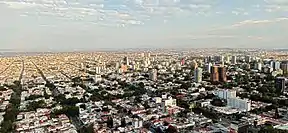Mexican Lowlands
El Bajío | |
|---|---|
Region | |
Templo Expiatorio (León), panoramic of Querétaro City, Rural landscape in Guanajuato, Ing. Antonio M. Amor refinery plant in Salamanca, Guanajuato, Colonial town of Lagos de Moreno, Downtown Querétaro, panoramic of Guadalajara. | |
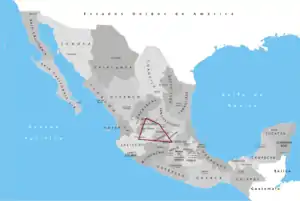 | |
 | |
| Coordinates: 20°28′24″N 101°12′02″W / 20.473335°N 101.200562°W | |
| Country | Mexico |
| States | Guanajuato, Aguascalientes, parts of Querétaro, Jalisco, Zacatecas, San Luis Potosí, Michoacan |
The Bajío (the lowland) is a cultural and geographical region within the central Mexican plateau which roughly spans from northwest of Mexico City to the main silver mines in the northern-central part of the country. This includes (from south to north) the states of Querétaro, Guanajuato, parts of Jalisco (Centro, Los Altos de Jalisco), Aguascalientes and parts of Zacatecas, San Luis Potosí and Michoacán.
Located at the border between Mesoamerica and Aridoamerica, El Bajío saw relatively few permanent settlements and big civilizations during Pre-Columbian history, being mostly inhabited by nomadic tribes known to the Aztecs as "The Chichimeca" peoples (the barbarians), another Nahua group from whom the Toltec and the Aztecs were probably descended. The tribes that inhabited El Bajío proved to be some of the hardest to conquer for the Spanish—peace was ultimately achieved via truce and negotiation—but due to its strategic location in the Silver Route, it also drew prominent attention from the Spanish crown and some of the flagship Mexican colonial cities had to be built there, such as Guanajuato and Zacatecas. Abundant mineral wealth and favorable farming conditions would soon turn the region into one of New Spain's wealthiest. At the beginning of the 19th century, El Bajío was also place to the ignition of the Mexican War of Independence, and saw most of its battles during the initial phase of the war, including the Cry of Dolores, the storming of the Alhóndiga de Granaditas and the Battle of Calderón Bridge.
Nowadays, the region features one of the strongest economies in Mexico and Latin America, drawing both domestic investment from the adjacent, industry-heavy State of Mexico, as well as foreign companies in seek for cheap specialized labor and decent infrastructure[1] (mostly American, Japanese and to some extent, European vehicle and electronics companies).[2][3][4][5] The largest cities of the Bajío are Guadalajara, León, Santiago de Querétaro, and Aguascalientes.[6]
History
Recent archeological studies of the Bajío have discovered an extensive historic cultural tradition that is unique to the region, particularly along the flood plains of the Lerma and the Laja Rivers. The Bajío Culture flourished from 300 to 650 CE, with cultural centers ranging from El Cóporo in the far north of Guanajuato to Plazuelas in the far southwest.[7] More than 1,400 sites have been discovered throughout the state of Guanajuato, with only the sites of Cañada de la Virgen, El Cóporo, Peralta, and Plazuelas having received extensive study. The region was also known as La Gran Chichimeca in later years and was the epicenter of the Chichimeca War in the 16th century and the cradle of Mexican War of Independence from 1810.
In the Bajío in April 1915, during the Mexican Revolution, General Álvaro Obregón provoked decisive battles against Pancho Villa, whose troops lost in June that year outside the city of Celaya, in the State of Guanajuato.
Geography
In general usage, the region is usually associated with the States of Guanajuato and Querétaro, even though those two states form only a part of the Bajío. It is now characterized by its highly mechanized agriculture, with mean precipitation in the order of 700 millimeters (28 in) per annum (one of the highest in the country). During the Viceroyalty of New Spain, the area was known as the breadbasket of the territory. As of 2014, the region produces sorghum, wheat and maize as its main crops.
The Bajío region lies in the basin of the Rio Lerma and Río Grande de Santiago.
States
| State | Aguascalientes |
Guanajuato |
Jalisco |
Querétaro |
| Seal |  |
 |
 |
 |
| Capital | Aguascalientes | Guanajuato | Guadalajara | Querétaro |
Secondary states sometimes considered as partly contributing to El Bajío or enclosing it: Michoacán, Zacatecas, San Luis Potosí and Estado de México (State of Mexico).
Demography
Largest cities
| Rank | City | State | Population (2020) | Metro Area (2020) |
|---|---|---|---|---|
| 1 | Guadalajara | Jalisco | 1,460,148 | 5,268,642 |
| 2 | León | Guanajuato | 1,721,199 | 2,140,354 |
| 3 | Santiago de Querétaro | Querétaro | 1,049,777 | 1,594,212 |
| 4 | Aguascalientes | Aguascalientes | 863,893 | 1,140,916 |
| 5 | Celaya | Guanajuato | 378,143 | 767,104 |
| 6 | Irapuato | Guanajuato | 452,090 | 529,979 |
| 7 | San Juan del Río | Querétaro | 177,719 | 402,112 |
| 8 | Salamanca | Guanajuato | 160,682 | 273,417 |
| 10 | Guanajuato | Guanajuato | 194,500 | 194,500 |
| 9 | Tepatitlán de Morelos | Jalisco | 98,842 | 150,190 |
 Guadalajara, Jalisco.
Guadalajara, Jalisco.
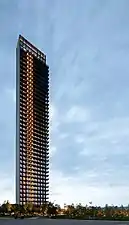 León, Guanajuato.
León, Guanajuato.
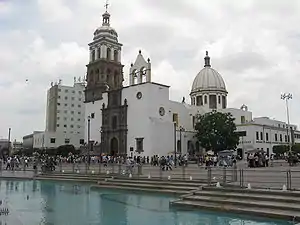 Irapuato, Guanajuato.
Irapuato, Guanajuato.
Economy


Today, the region is one of the fastest-growing in the country. This has caused the metropolitan areas to attract many migrants from other parts of Mexico.[8][9][10] The region has had an outstanding industrial and economic development in the last 15 years. The cities of El Bajío have one of the highest income per capita figures in Mexico.[11]
Tourism
Due to its colonial heritage, the Bajío is home to around eight UNESCO World Heritage Sites (depending on how its limits are defined):
- Downtown Querétaro City.
- Franciscan Missions in the Sierra Gorda (shrines in the rural Querétaro Huasteca region, by Junípero Serra, also founder of many Californian missions).
- Guanajuato City and adjacent mines.
- San Miguel de Allende and Sanctuary of Jesús Nazareno de Atotonilco (town in the state of Guanajuato).
- Hospicio Cabañas (colonial hospital complex and art museum in Guadalajara).
- Agave Landscape and Ancient Industrial Facilities of Tequila (Jalisco).
- Zacatecas City
- Camino Real de Tierra Adentro
- Downtown Morelia
Industry
El Bajio has long been a hub for the national industrial market, because it naturally sits between Mexico's three main cities: Mexico City to the south, Guadalajara to the west and Monterrey to the northeast.[12] The region has attracted foreign companies due to its relative proximity to the United States, second only in American manufacturing plants to the Mexico-US border. Faster access to port cities such as Manzanillo, Tampico and Veracruz compared to border cities is also attractive for Asian and European markets. The main investor was Japan, although the United States, South Korea, Germany, France, Italy and Spain also have important presence in the area.[12][13] It is estimated that, by 2016, Asian foreign direct investment totaled over 1.5 billion dollars. Guanajuato (León-Silao and Celaya) hosts General Motors, Pirelli, Honda, Toyota, Mazda, Denso, Mitsubishi, and Sumitomo plants. Aguascalientes hosts Nissan, Renault, Mercedes, Yazaki and Jatco plants. Querétaro hosts Mitsubishi, Samsung, Bombardier and Safran plants. San Luis Potosí hosts BMW and Yazaki.[12] The State of Mexico (Cuautitlán Izcalli) hosts a Ford plant.
Bajío Shimbun is a monthly, Japanese-language newspaper founded in June 2015.[14] The first Japanese consulate was inaugurated in January 2016 in León to serve the Bajío region.[15] As of 2017 there were 1143 Japanese, 294 United-Statesians and 200 Spanish legal immigrants in Aguascalientes according to the immigration authorities, although the total number of immigrants is thought to be much higher.[16] In 2015, authorities reported a total of 6230 legally-registered immigrants in the state of Querétaro, most of them from the United States, Spain, Colombia, South Korea, Germany, Cuba, France, Canada, Japan and Venezuela.[17]
Now archetypal in the development plans of the local governments, these business partnerships with multinational corporations have been criticized for exploiting Mexico's weak labor laws and low wages,[18][19] lacking long-term potential of benefiting the local population and for outsourcing jobs out of their countries of origin in the developed world.[20]
Culture
The Bajío is known for being the cradle of Mexican independence from the Spanish Empire, and for being one of the conservative bastions of Mexican Catholicism.
 Pabellón de Hidalgo, Aguascalientes.
Pabellón de Hidalgo, Aguascalientes.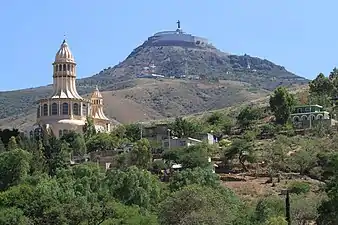 El Cubilete hill, Silao, Guanajuato.
El Cubilete hill, Silao, Guanajuato. San Juan de los Lagos, Jalisco.
San Juan de los Lagos, Jalisco.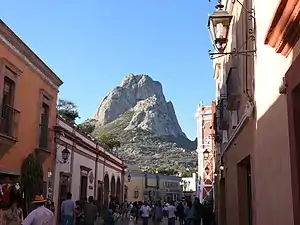 Bernal, Querétaro.
Bernal, Querétaro._-_panoramio.jpg.webp) Plantations near Salamanca, Guanajuato.
Plantations near Salamanca, Guanajuato. Guanajuato, Guanajuato.
Guanajuato, Guanajuato.
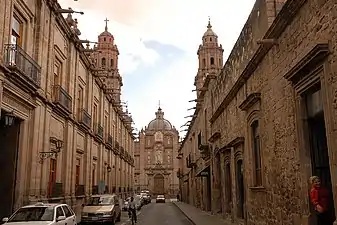 Morelia, Michoacán.
Morelia, Michoacán.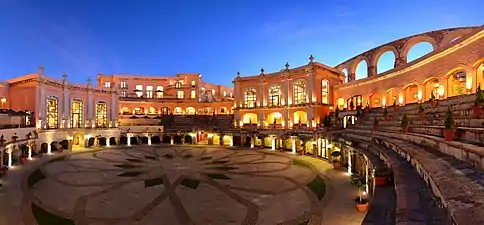 Zacatecas, Zacatecas.
Zacatecas, Zacatecas..JPG.webp) San Luis Potosí, San Luis Potosí.
San Luis Potosí, San Luis Potosí. Teotihuacán, Estado de México.
Teotihuacán, Estado de México.
See also
References
- ↑ "Mexican manufacturing - from sweatshops to high-tech motors". Reuters. April 9, 2013. Retrieved March 3, 2023.
- ↑ "The so called great Bajio in Mexico: a case of booming economic regional growth". RSA Main. Retrieved November 13, 2022.
- ↑ Winterfeldt, Liv (April 13, 2022). "The Bajío Region: Engine of the Mexican Economy". WMP Mexico Advisors. Retrieved November 13, 2022.
- ↑ "As Mexico's Commercial Real Estate Soars, Second Tier Cities Attract First-Rate Attention". Nearshore Americas. June 16, 2014.
- ↑ "Entrada Group: at the heart of Mexico's thriving manufacturing industry". European CEO. January 10, 2014. Retrieved September 19, 2015.
- ↑ "The Bajío Guide - Mexico Travel". Rough Guides. Archived from the original on May 9, 2014. Retrieved January 16, 2014.
- ↑ Butzer, Karl and Elisabeth Butzer. 1997. "The Natural Vegetation of the Mexican Bajío: Archival Documentation of a Sixteenth Century Savannah Environment." Quaternary International 43, no. 4: 161-72.
- ↑ "Junto Con El Crecimiento De La Ciudad, Crecen También Los Servicios Públicos Municipales Con Calidad En Beneficio De Los Habitantes Del Municipio" [Together with the growth of the city, grow also the municipal public services with quality to Benedit the inhabitants of the municipality] (in Spanish). Querétaro: Municipality of Querétaro. July 30, 2007. Retrieved November 12, 2009.
- ↑ "Querétaro, emblema de México: Le Figaro". Archived from the original on September 22, 2013. Retrieved September 8, 2013.
- ↑ "Boom en El Bajío, nuevo polo industrial de México". June 2, 2013.
- ↑ "Querétaro atrae los centros de datos | Datacenter Dynamics". Archived from the original on September 27, 2013. Retrieved September 8, 2013.
- 1 2 3 Beltran, Maria Elena Peyro; Medina, Martha Virginia Gonzalez; Perez, Angelina Hernandez (May 2, 2019). "La inversión asiática en el sector automotor de la región del Bajío, México". Expresión Económica. Revista de análisis (in Spanish) (42): 29–54. doi:10.32870/eera.vi42.896. ISSN 1870-5960.
- ↑ "Querétaro, el nuevo territorio japonés". El Financiero. Retrieved October 18, 2014.
- ↑ "Leoneses lanzan periódico en japonés". Unión Guanajuato. Retrieved July 16, 2016.
- ↑ "Japón abre consulado en León, Guanajuato". El Financiero. Retrieved July 16, 2016.
- ↑ "Japoneses en Aguascalientes y en la Región / El apunte - La Jornada Aguascalientes (LJA.mx)". La Jornada Aguascalientes (LJA.mx) (in Mexican Spanish). May 23, 2017. Retrieved July 14, 2017.
- ↑ "En Querétaro viven personas de 91 países". El Universal Querétaro. Retrieved November 20, 2022.
- ↑ Ríos, Viri (November 7, 2022). "Cómo León se convirtió en la ciudad más pobre de México" [How León became the poorest city in Mexico]. Grupo Milenio (in Mexican Spanish).
- ↑ Partlow, Joshua (June 18, 2015). "Workers may be losers in Mexico's car boom". Washington Post. ISSN 0190-8286. Retrieved November 14, 2022.
- ↑ Levin, Sandy (December 5, 2017). "The outsourcing of US jobs to low-wage Mexico". The Hill. Retrieved November 14, 2022.
Further reading
- Brading, D.A. Haciendas and Ranchos in the Mexican Bajío: Léon, 1700-1860. Cambridge: Cambridge University Press 1978.
- Murphy, Michael A. Irrigation in the Bajío Region of Colonial Mexico. Boulder: Westview Press 1986.
- Ocaranza Sainz, Ignacio. Estudio geográfico y económico del Bajío, Universidad Nacional Autónoma de Mexico, 1963
- Sánchez Rodríguez, Martín, "Mexico's Breadbasket: Agriculture and the Environment in the Bajío" in Christopher R. Boyer, A Land Between Waters: Environmental Histories of Modern Mexico. Tucson: University of Arizona Press 2012, pp.50-72.
- Wright Carr, David Charles (1999). La conquista del Bajío y los orígenes de San Miguel de Allende, Universidad del Valle de México-Fondo de Cultura Económica, México.
External links
- http://www.cuentame.inegi.org.mx/territorio/rev/index.html
- http://www.inegi.org.mx/sistemas/mexicocifras/default.aspx?e=11&i=i
- http://www.e-local.gob.mx/work/templates/enciclo/guanajuato/hist.htm
- http://www.historicas.unam.mx/moderna/ehmc/ehmc14/187.html
- https://web.archive.org/web/20101223114649/http://www.bicentenario.gob.mx/bdb/bdbpdf/NBNM/R/23.pdf






